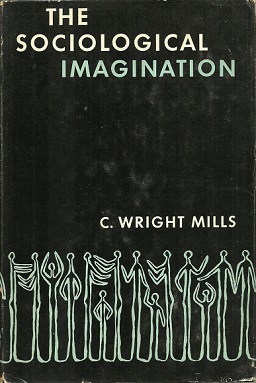A short slightly adapted extract from chapter 5 of Stigma
Sociological Imagination
In The Sociological Imagination (1959), the American sociologist Charles Wright Mills famously stated that ‘no social study that does not come back to the problem of biography, of history and their intersections within a society has completed its intellectual journey’.[i] Indeed, the promise of sociology is the critical sensibility which it cultivates when we tease out ‘the public issue or problem contained in the private trouble’.[ii] This forging of connections between the personal and the political, between individual biographies and the histories that shape them, is particularly urgent today. As the sociologists Nicholas Gane and Les Back argue, ‘in a neoliberal world which seeks to tear asunder private troubles from public issues, and thereby turn social uncertainty into a personal failure that is divorced from any collective cause or remedy, the linking of biography and history is a vital part of a sociology that is both politically and publicly engaged.’[iii]

‘gifted with second-sight of seeing yourself’
Wright Mill’s understanding of sociology as an imaginative practice which ties individual biographies to history has its roots in the extraordinary body of work produced by the sociologist W. E. B Du Bois (1868–1963).[iv] For Du Bois, being a black man in America ‘at the dawning of the Twentieth Century’ bestowed on him a ‘double-consciousness’, which he describes as being ‘gifted with second-sight of seeing yourself’. [v] It is ‘a peculiar sensation’, he writes, ‘this sense of always looking at one’s self through the eyes of others, of measuring one’s soul by the tape of a world that looks on in amused contempt and pity.’ [vi] In The Souls of Black Folk, a collection of essays published in 1903, Du Bois puts this gift of double-consciousness to work as a sociological method, deftly weaving together autobiographical experiences, the ‘Sorrow Songs’ of black spirituals, social history, and economic and statistical data into a shattering account of the ‘studied humiliations’ of anti-black racism. [vii]

Stigma is a distinctly psychosocial concept. What I mean by this is that it is a concept which describes the traffic between the individual and the social world, between personal troubles and social, political and economic forces. Stigma power is an analytic that allows us to examine the relay between practices which impress stigma upon people, and how these impressions affect the ways in which people perceive themselves and others. It is important to pay attention to stigma precisely because it captures the movement between external and internal processes of de/valuation. Stigma is a productive force that marks out and classifies people as a means of subjugating them; a disciplinary form of power that seeks to change people, to change attitudes and behaviour, and how people make value judgements about others. It is a dehumanising force of power that infiltrates, pierces and deflates your sense of yourself. Stigma functions through subjection; it makes people abject.[viii]
‘a shimmering alertness… to what things come together to make us up’
Yet, as Du Bois suggests, being stigmatised can provoke a consciousness of the ways in which we are ‘figured against the backdrop of history’.[ix] The doubling of consciousness effected by social stigma – between experiences of being devalued or dehumanised by others and an awareness of oneself as human and valuable nonetheless – makes us wakeful. Resisting stigma generates what the poet Dionne Brand describes as a ‘shimmering alertness’ to ‘what things come together to make us up at a particular moment’.[x] It stirs an awareness of how power is written on our skin, awakening us to the relationship between our biographical lives and the stigmatised positionalities scripted for us by others. Indeed, I made the decision to include some autobiographical fragments from this shadow stigma project in [a chapter on my Stigma book], precisely because my experiences of being stigmatised, including the formative experience of discovering myself caught in the anthropological gaze, have been such important critical gift in my subsequent work as a sociologist, a teacher, a writer, a poverty commissioner, an activist.
stigma as a resource for resistance
One of the arguments of Stigma is that the double-consciousness affected by being stigmatised effects is a resource for resistance and change. That is, being aware of how we are ‘figured against the backdrop of history’, makes us question those systems of economic injustice, practices of political domination and stratified social hierarchies which we might otherwise simply absorb or passively accept as inevitable or deserved.[xi] As the poet Dionna Brand puts it, ‘One enters a room and history follows; one enters a room and history precedes’. She goes on:
History is already seated in the chair in the empty room when one arrives. Where one stands in a society seems always related to this historical experience. Where one can be observed is relative to that history. … How do I know this? Only by self-observation, only by looking. Only by feeling. Only by being a part, sitting in the room with history.[xii]

References
[i] Charles Wright Mills, The Sociological Imagination (Harmondsworth: Penguin, 1959), 6.
[ii] Nicholas Gane and Les Back, “C. Wright Mills 50 Years On: The Promise and Craft of Sociology Revisited,” Theory, Culture & Society 29, no. 7–8 (2012): 405.
[iii] Gane and Back, 405.
[iv] See Aldon Morris, The Scholar Denied: W.E.B Du Bois and the Birth of Modern Sociology (Oakland: University of California Press, 2015), for an account of the segregation of Du Bois’ work and that of his Atlantic School from the sociological canon.
[v] Du Bois, The Souls of Black Folk, 9.
[vi] Du Bois, 9.
[vii] Du Bois, 153.
[viii] For an account of what I term ‘social abjection’ see Tyler, Revolting Subjects: Social Abjection and Resistance in Neoliberal Britain.
[ix] Dionne Brand, Convocation 2018: University of Toronto, 2018, https://www.youtube.com/watch?v=zJKmp6eh6Ag.
[x] Brand.
[xi] Brand.
[xii] Dionne Brand, A Map to the Door of No Return: Notes to Belonging (Toronto: Vintage Canada, 2001), 25.
